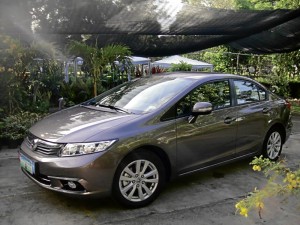When 8th generation Honda Civic was launched in Manila in April 2006, Shimichi Takahashi, project leader of the Honda Civic Development Team, said that their aim was “to excite the customer by just looking, touching and driving the Civic. We wanted it to be a ‘wow’ car.” The title of my review thereon was “The Civic gets back its mojo” as I wrote that the totally new 2006 Civic was clearly designed to appeal to the emotions with a capital E via its rakishly angled windshield, aerodynamically flowing roof, cab forward monoform body, short overhangs and low ground clearance.
Fast forward to February 2012, when the long-awaited 9th gen Civic was unveiled before the motoring media. Masayuki Sano, Large Project Leader of Honda R&D Co. Ltd., said in his technical presentation of the 2012 Civic that fuel efficiency, clean energy and smart technology were given high priority in its development. Sano also mentioned the “Fun to Drive” objective, but after you inspect and test-drive the new Civic, you begin to wonder what happened to the “wow” factor, the excitement and emotions more often than not evoked by the sporty Civic during its 40-year history.
The 2012 Civic was expected to be a full model change, but apparently Honda chose to play it safe by basically retaining the winning monoform shape of the 2006 model, which was a best-selling compact sedan worldwide. Honda added improved fuel efficiency, riding comfort and a quieter interior as the major updates. You have to look hard to find the subtle changes in the new Civic’s exterior, unless you look first at the rear and see the larger taillights.
Carryover. The 1.8 liter, 140 hp SOHC i-VTEC engine with 128 lb-ft max torque is a carryover from 2006, likewise the 5-speed automatic transmission while most competitors have upgraded to a 6-speed AT or CVT. The Civic’s 5-speed AT delivers power immediately but when the car reaches highway speeds it begins to fall a little flat and the driver yearns for a sixth gear. Honda claims, however, that the 5-speed AT is the most fuel-efficient tranny for the Civic.
The suspension is also the same: McPherson strut up front and Multi-Link at the rear, but Honda claims that the suspension stroke has been increased fore and aft, the damper sliding function has been increased for improved stability, riding comfort and smoothness and less bumpiness. The chassis has a greater percentage of high-strength steel and is 7 percent lighter and 10 percent stiffer than before, Honda says.
Modifications to the electric power steering resulted in less feedback than before and a greater sense of isolation from the road. Some may like this, but the sporty personality is lost. The new Civic feels larger than its predecessor as it turns into corners less authoritatively, has a stiffer body, increased sound deadening and slower steering ratio. A greater amount of body roll and understeer has also been noted.
Familiar. The interior design of the 2012 Civic hasn’t changed much, retaining the two-tier instrument panel, familiar-looking dials and gauges and hard plastics. What instantly catches your eye is the green ECON button on the left side of the dash. When you push the ECON button, the Civic’s Eco Assist Technology is engaged, controlling the engine, drive-by-wire, transmission and air con to further improve fuel efficiency. When you drive aggressively, the Eco coaching ambient bars on both sides of the speedometer turn blue, then glow green when you drive in a fuel-conserving manner.
Another update to the instrument panel is the 5-inch Intelligent Multi-Information Display that allows the driver to easily customize the various vehicle settings. The I-MID integrates Bluetooth, fuel economy data, trip info, climate, clock and audio, among others.
The cabin feels wider and more open due to thinner A pillars and a relatively low belt line. Visibility is good. The front and rear seats are comfy and easy to adjust, while legroom in the rear has gained about 2 inches. There are 12.5 cubic feet of trunk space.
Lighter. The smaller grille opening, slab-sided body panels and flat underbody aside from the lighter weight of the Civic unibody lower the coefficient of drag and contribute to fuel efficiency as do reduced internal friction and has a bit more torque down low. The Civic averages 13 kilometers per liter in combined city and highway driving, up from 12 before. But that fuel efficiency is surpassed by some competitors that are quicker, more stylish, more spacious and have a lower retail price.
The Civic’s safety rating is excellent, given its Vehicle Stability Control, ABS with electronic brake force distribution, brake assist, a rear view camera and front airbags. The Civic sold in other markets has side curtain airbags, but I’m not sure whether the Civic sold here does. The only model sold in the Philippines at present is the EXi AT imported from Japan with a suggested retail price of P1.074 million.
Bottom line, the new Civic is more fuel-efficient, quieter, more spacious and more comfortable than before. It has smart onboard technology, a proven reliability record, impeccable build quality and excellent safety features. It is easy and pleasant to drive, delivers good value for money and will have a high resale value. However, it lacks the passion and sporty driving dynamics of its predecessor and faces fierce competition from other brands that cost less. Honda Motor Co. in Japan may be resting on its laurels with the 2012 Civic, but watch out when it wakes up to become the class leader again.
